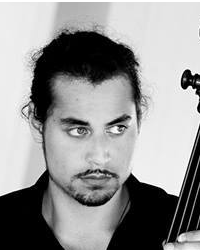Josh
About
- Username
- Josh
- Joined
- Visits
- 255
- Last Active
- Roles
- Member, Moderator
Comments
-
Hi, Using a long sound sample is a good idea. I think you will need to make a while-loop in an inline_script run-phase that looks something like this: from openexp.keyboard import keyboard your_keyboard = keyboard(exp) # just so you can use…
-
Have a rose!
-
Hi, Like you said yourself; "as if the eyes were closed". This is correct: one has to blink occassionally. During a blink the coordinations can go all over the place, due to loss of signal or a misinterpretation (e.g. eyelashes). On top o…
-
Hi Miko, You may want to try this function: http://osdoc.cogsci.nl/python/canvas/#function-__canvasimage__fname-centertrue-xnone-ynone-scalenone , where you can indicate your scale parameter value. This would require a canvas object rather than a f…
-
Hi, As far as I know, the drift correction module only works with an actual eye-tracker! Cheers, Josh
-
Looks pretty good Pad, maybe combine the two? So a line between two sets of coordinates, but also a dot at each of those coordinates.. [EDIT: only now do I see you already tried this, but it makes the program laggy.. you could maybe place only the …
-
Hi, Step one is to draw a canvas (similar to sketchpad, see http://osdoc.cogsci.nl/python/canvas/) Step two is to collect a mouse response, see http://osdoc.cogsci.nl/python/mouse/ The mouse response contains a button as well as coordinates, and …
-
Hi Michelle, This should be possible. There have been similar threads over time, like this one http://forum.cogsci.nl/index.php?p=/discussion/6/solved-voicekey-input-triggering-responses-through-sound-input/p1 A quick glance suggests that you can …
-
Hi, Could it be that the commands that play your sounds are placed in the prepare phase of an inline_script? Prepare phases are run before everything else, so that could explain why you hear your sounds right away.. And yes, the self.sleep() comma…
-
Hi Mikael, Are you talking about pupil size data, position data, or both? Could you copy a line from your logfile? For example one that starts with EFIX. I suspect this to be something related to the Eyelink setup rather than OpenSesame, but I can'…
-
Hi KL, As far as I know, you can indicate whether you want the video to be fitted to the size of your screen, or in the original format. Altering the resolution of your experiment may also work. If all else fails, you may find some tools online to …
-
Hi, There may be other ways to display text justified, but the only one I can think of would require a bit of coding. Basically you would add words to a string and check after every addition if the size of the string would cross a certain threshold…
-
Heh. The folder that the file is in, is your experiment folder. So if the .osexp file is in a dropbox folder named "blargh", then "blargh" is your experiment folder, and in "blargh" you can create a folder named undersc…
-
Alright, the .osexp folder is the experiment folder ;) Cheers
-
Hi Yuij, Where did you save your experiment? Cheers
-
Hi, Your plan is clear. Are you stuck at a specific point, or do you want us to tell you exactly how to do everything? In case of the latter, it may be best for you to do an OpenSesame tutorial first; see http://osdoc.cogsci.nl/tutorials/step-by-s…
-
Great that you solved it! Cheers
-
Hi Yuij, The experiment folder would be the folder that contains your experiment. You can create a folder named _ pool _ (that's underscore underscore pool underscore underscore, without spaces) in this folder, and put your wav and bmp files there.…
-
Hi Amandine, Did you insert a drift correction item at the start of each trial? Josh
-
Hi Nynke, Your idea with the tree is logically correct and therefore possible, but as you already reckoned, too much of a hassle. It'll be best for you to use an inline_script. You could basically create the whole trial in a single inline_script, b…
-
Woops - apologies for the confusion!
-
Hi Pia, To add to Knante's comment: you can run two versions simultaneously, but in order to do this you'll have to download the source code (http://osdoc.cogsci.nl/2.9/getting-opensesame/running-from-source/) rather than the installer. The source…
-
Hi Pia, Based on the information currently provided I can't say what causes your problem. If you have just one keyboard_response item, one button press should be enough. It could be that you have other sketchpad items for which the duration is stil…
-
Hi Tom, If you define the variable "go" twice, then the second one will overwrite the first, so they'll have to be named differently. Your first block loop seems problematic as well though... You defined a variable condition and a variab…
-
Hi Grusha, I'm sorry for your loss of data..! The Esc button has been a slippery customer up until the release of version 3.0. Since version 3.0, the Esc button will trigger a pause screen, from where you can exit the experiment by pressing Q. To a…
-
Double help - awesome
-
Hi Nadam, You were already pretty close to the solution :) You need to switch your values around; random.randint(100,400). You can't enter this command in the duration box directly though. So before the sketchpad, you could insert an inline_script …
-
Hi Tom, Thanks for the clarification. As your 8 blocks are contained by 8 loop items (I assume), you could in each respective loop item define the variable go with value set to emotional for blocks 1,3,5 & 7 and neutral for blocks 2,4,6 & 8…
-
Hi Tom, Just to be sure... when you say "neutral go and emotional go conditions are alternated", do you mean alternating from trial to trial, or from block to block? Do you want the types of emotions to be randomized from trial to trial,…
-
Hi Tom, Are you sure you want to do that? Participants will surely learn that after every "go", the next trial is going to be a no-go. This will mess up your data. Moreover, following your rule, there could still be a sequence of 4 succes…



